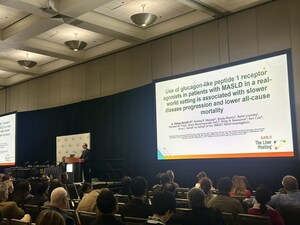DURHAM, N.C., March 29, 2022 /PRNewswire/ -- New real-world data evaluating alanine aminotransferase (ALT) in children uncovered disparities in prevalence and severity of non-alcoholic fatty liver disease (NAFLD). The study, Variation in Alanine Aminotransferase in Children with Non-Alcoholic Fatty Liver Disease, was published in the peer-reviewed journal Children. The data was culled from the ongoing observational TARGET-NASH cohort, sponsored by real-world evidence leader Target RWE.
NAFLD has developed into one of the most common chronic diseases, affecting children as young as two years of age, and the prevalence is continuing to increase.1,2 The rate of pediatric patients with NAFLD has more than doubled in recent decades and has persisted across gender and racial/ethnic subgroups.3 The prevalence of NAFLD has substantially increased with the increasing rates of obesity in children.1
This new study describes the distribution of clinical and metabolic characteristics among children enrolled in the large real-world data cohort TARGET-NASH. Researchers stratified the distribution of peak ALT levels as well as the distribution of clinical characteristics by both history of a biopsy and peak serum ALT level (≤70, >70 to ≤250, and >250 U/L) to identify comorbidities and treatment patterns in this growing, but understudied population.
The analyses included 660 children with a median age of 13 years. Key findings include:
- A total of 187 children had undergone a biopsy, were more likely to be Hispanic or Latino (67% vs. 57%) and to have cirrhosis (10% vs. 1%).
- The prevalence of cirrhosis or any liver fibrosis stage was most common among children with a peak ALT > 70 U/L.
- The prevalence of Type 2 diabetes was 2.2 times as likely among children with an ALT >250 U/L compared to children with a peak ALT between 71 and 250 and children with a peak ALT ≤ 70 U/L.
"There were a surprisingly high number of pediatric patients with a peak ALT greater than 250 within this diverse real-world cohort," said Eduardo Castillo-Leon, MD, Department of Pediatrics, School of Medicine, Emory University. "Previous studies examining pediatric NAFLD have occurred mainly in controlled trials with very specific inclusion/exclusion criteria and an inability to look at the progression over time in a real-world population. The wide inclusion criteria for this study allowed the analysis of those patients with normal to mildly elevated values of ALT, a population that is often overlooked."
"Higher levels of ALT were associated with increased prevalence of comorbidities and more advanced stages of NAFLD, particularly among Hispanic children," said Miriam Vos, MD, MSPH, Department of Pediatrics, School of Medicine, Emory University, and physician at Children's Healthcare of Atlanta. "These findings support an increased need for therapeutics and disease severity assessment in children with high ALT levels."
The analyses included children enrolled between August 1, 2016, and October 12th, 2020, with at least one ALT measurement after enrollment.
TARGET-NASH is a real-world longitudinal observational cohort of adult and pediatric participants with NAFLD and/or NASH receiving usual care from academic and community centers in the U.S. and Europe, enrolling over 7,000 participants to date.
About Target RWE
Target RWE is a leading health evidence solutions company that generates innovative real-world evidence (RWE) and provides scientific intelligence tools and solutions for healthcare partners.
Target RWE's data sets and evidence, modern epidemiological methods, and sound scientific principles rendered as software can be utilized to better health outcomes, inform patient health guidelines, and improve the overall quality of care. Visit www.targetrwe.com for more details.
CONTACT:
Kayla Slake
[email protected]
984.234.0268 ext. 205
SOURCE Target RWE

WANT YOUR COMPANY'S NEWS FEATURED ON PRNEWSWIRE.COM?
Newsrooms &
Influencers
Digital Media
Outlets
Journalists
Opted In





Share this article